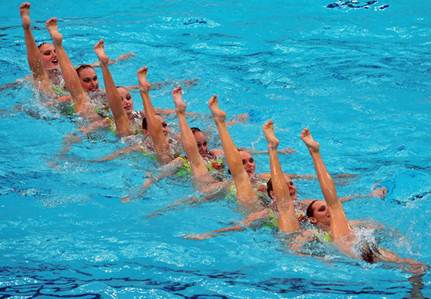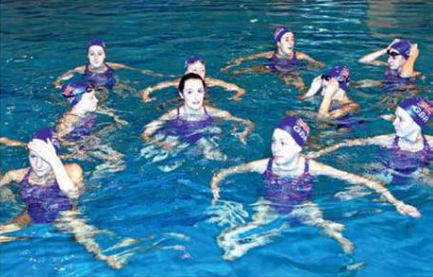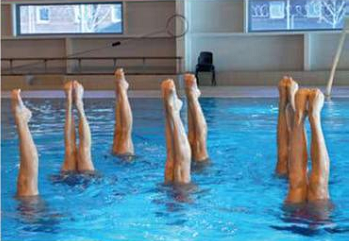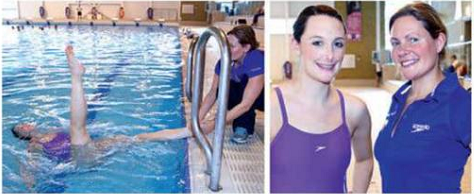Totally hyped about
the Games, every month we’ll be joining our Olympic heroes for a training
session - and an insight into what it takes to win gold. First off, Zest's Laura
Potter is in at the deep end with the GB synchronised swimming team

OK, so I've a confession to make. I'm
not a natural swimmer and when it comes to gymnastics - does mastering a
roly-poly count? The thought of combining both these 'talents' to train with
the British synchronised swimming team is seriously daunting. But I'm a Zestie
after all so, undeterred; I pack my swimsuit and goggles and head off to meet
them. By the time I arrive at Aldershot's specially-deep training pool at 1 lam
(you're not allowed to touch the bottom in synchro routines), they’ve already
been in the water for four hours! Turns out their training regime is a
gruelling 42 hours a week - 30 in the water and the rest in the gym, I'm
shattered just thinking about it.
'A typical day is a 45-mmute workout,
then an hour and a half of speed swimming, four hours of synchro, a break for
lunch, then back in the water for another few hours,' says senior squad member,
Katie Dawkins. 'We also do lots of Pilates and weight training for the lifts.
It's hard work, but our sport demands perfection.' All that hard work is
definitely paying off - the team has jumped from 20th in the world five years
ago to eighth this year and is targeting a top-six finish for 2012.
As I join them, the team is already
practising the routine they'll showcase at the Stratford Aquatic Centre come
July. It's a flurry of pointed toes, twirling limbs and winning smiles. Every
movement is precise, perfectly timed and covers the length and breadth of the
pool. This is going to be a challenge!
First up, the team's high-performance
coach, Adele Carlsen, teaches me a basic 'back layout scull’, which forms the
foundation for many moves. You have to stay completely flat on the water, while
sculling your arms. I'm pushing my hips up and tensing every muscle just to
avoid sinking. It's much tougher than it looks. Either my hips are up but my
toes aren't pointed, or my toes are pointed bur my legs aren't tense - as soon
as I get to grips with one element another goes all to pot. Who knew floating
was so difficult?

The
team prepares for Laura’s lift
Now it’s time for a 'move'. Adele
begins by tempering my expectations: it's possible that I may not perform this
move with effortless grace, as most newbies wouldn't attempt it for at least a
month. It's called a 'ballet leg single' and involves lying flat, sculling
along, with one leg straight up in the air. Oh, God. Adele grips one of my feet
as I desperately attempt to stay afloat. As she lets go, I raise my teg, my
hips drop, my bum plummets and I sink like a stone - I can only imagine how
tragically ungraceful I look. A few more words of encouragement and I've just
about managed to keep a bent leg in the air for a millisecond before sinking
without trace again. I'm now beginning to see how tough this sport really is.
The synchro team may look calm and elegant on the surface, but underneath their
bodies are working furiously hard. How they manage to do all that and smile is
beyond me.

Showing
off her ballet leg.
Next, I have to tackle my nemesis, the
underwater somersault - and a backwards one at that. As 1 cling to the side,
knuckles whitening (dramatic, me?), Adele tells me to tuck my knees in. she'll
roll me halfway and gravity will do the rest. It sounds easy, but once she's
sent me spinning I'm completely disorientated, A few more words of
encouragement, a little trust in gravity and I finally make it all the way
round. At which point, Adele asks me to lengthen out my body halfway round and
point my toes to the ceiling. I wonder why I ever thought Zumba routines were
complicated.

Coach
Adele helps (smiling underwater) perfect a move. Laura is successfully
launched.
Synchro bootcamp complete, it's time
to attempt a lift. The squad has enlisted the help of figure-skating supremo
Robin Cousins to supercharge their lifts, which they practise on land, then
transfer to water - like Dirty Dancing, but in reverse. And guess who gets to
emerge, Venus like... The girls will surround me, then dip under the water,
grab my feet and launch me skywards. They recommend falling backwards if I lose
my balance so no one gets injured, but by some miracle I stay standing!
Training over, I have a newfound
respect for these sportswomen. Synchro is physically, technically and mentally
demanding. Eight people have to be perfectly synchronised and every sinew in
their bodies perfectly placed. I'm proud I've performed a routine with Team GB
- but doubt ill have been talent-spotted!
For more tips from the squad, and to
learn the body benefits synchro swimming can deliver, visit sesi.co.uk.
LEARN THE LINGO
DUET: Two swimmers can perform
a routine. Look out for our girls, Commonwealth medallists Olivia Allison and
Jenna Randall, in 2012.
BACK
LAYOUT:
The most basic position. The swimmer lies on her back with her face, chest,
thighs and feet at the surface of the water.
SCULL: Different hand movements
used to propel the body are the most essential part of synchro.
BALLET
LEG: One
leg is extended at 90 degrees to the surface of the water, with the body in a
back layout position.
SOMERSAULT
BACK TUCK:
Knees are tucked into chest, nose to knees, the swimmer then pushes her
bottom up to propel herself into a backwards somersault.
EGGBEATER
KICK: A
way of treading water that keeps you stable vertically at chest height in the
water with your hands free to perform strokes